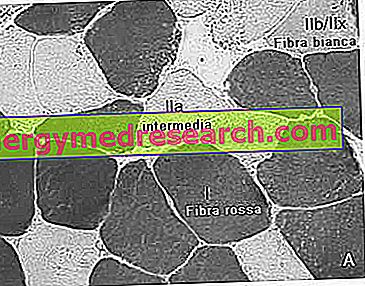Red fibers vs white fibers
In physiology the distinction between white and red fibers derives from the correlation between the color of the muscle cell and its speed of contraction.
The "white muscles" (or better, clear) are mainly glycolytic (anaerobic glycolysis energy metabolism), therefore faster but less resistant than the red ones; vice versa, the red muscles are more "efficient" (less strength and greater economy in effort) but, from the energetic point of view, less "effective" in the contraction.
Thanks to all the physiological parameters collected it is possible to make a more specific description
- both fast fibers (white glycolytic - type IIB - αw - Fast Glycolytic [FG])
- and slow ones (oxidative reds - type I - βr - Slow Oxidative [SO]).
In fact, between these two categories there is a third intermediate one, given by the
- light fibers (type IIA - αr - Fast Oxidative Glycolytic [FOG])
which has the ability to specialize as "glycolytic" or "oxidative". In practice, depending on the training stimulus, the intermediate IIA fibers can evolve into white glycolytic or red oxidative (but also in between).

Characteristics of white fibers
White fibers are functional units of skeletal muscle that transform the chemical energy of the bonds present in adenosine triphosphate (ATP) into kinetic / mechanical energy.
White fibers include both glycolytic (IIB) and intermediate (IIA), but the latter (which need a broader and more in-depth description) will be carefully treated in a dedicated article.
The white fibers are paler than the red ones, because:
- They do NOT contain significant amounts of mitochondria and myoglobin
- They have a lower density and capillary branching.
It is therefore established that, compared to the red ones, the white fibers have a greater contraction speed and mainly exploit the ANAEROBIC GLYCOLYSIS (from the reserve glycogen). In fact, the white fibers are able to effectively catabolize also Creatine Phosphate (CP - metabolism almost absent in the red fibers), fully exploiting the ANAEROBIC ALACTACIDAL path even for a few seconds at the beginning of the effort. It follows that, in addition to the aforementioned structural differences, white fibers contain a SPECIFIC enzymatic pool, therefore totally different from that of red fibers; translating physiology into athletic terms:
- the white fibers are more suitable for fast and intense stresses [of the ANAEROBIC type, both lactate (anaerobic glycolysis) and alactacid (creatine hydrolysis phosphate)] rather than long and moderate .
The muscles (or better, the motor units) that contain more white fibers than the red ones are those that perform mainly rapid contractions, to the detriment of resistance but to the advantage of the tension produced (pure force); this category includes the large muscles of the torso (good part of the pectoralis major) of the back (large dorsal), of the arms (triceps) and of the legs (such as the vast medial, the femoral rectum and the soleus).
It is clear to the reader that the distribution of white fibers, rather than red or intermediate ones, is NOT well defined; in addition to the subjectivity, training and the type of effort to which the muscle is delegated, there are significant heterogeneities even within the same district (various types of motor units). The high, intermediate or low bundles of a muscle do not NECESSARILY contain the same amount of white fibers, indeed!
- The pectorals and quadriceps are a clear example of how the concentration of white or red fibers can change from one bundle to another in the same district.
Training: optimization of white fibers
The training of white fibers must concentrate on the development of contractile strength and speed. The type of specific training varies according to the athletic discipline but, due to the correlation between strength and speed, the most widely used general preparation technique is that of "overloads".
The training of white fibers is of an anaerobic, lactic acid or alactacid type. To stimulate the alattacid component (CP) it is essential to carry out very short series of "lifting weights" (by force) or repeated clicks (for the SPECIFIC speed). The recovery must be abundant or at least sufficient, and the number of series weighted according to the level of preparation and the objectives.
On the contrary, if the intent is to stimulate the lactic acid metabolism of white fibers (resistant force of short duration or resistance to speed), the number of the series and the execution time of the same increase proportionally to the required resistance time (30 seconds, 1 minute, 3 minutes etc.) and recoveries must be calculated based on the number of programmed series.
A practical example of the development of maximal and explosive strength (alactacid metabolism - CP) on the white fibers is that of the weight lifter or even the launcher (weight, disk or hammer) that develops through the execution of multi-joint exercises (deadlifts, pushes in flat bench etc.) repeated in various series of 2-3 repetitions and interspersed with complete recoveries ranging from 2 to 5 minutes.
Wanting to propose an example of training for the "short resistant force" of the legs (and not for the long resistant strength which also involves a significant commitment of aerobic metabolism - red fibers) the most classic exercise, as well as one of the most effective, is the squat (with or without leap) in series at least over 15 repetitions.
Finally, remember that white fibers, although mostly anaerobic, are also involved in medium and long-term executions; they (with the intermediate IIA ones) are responsible for the production of lactic acid in the above-mentioned efforts of the anaerobic threshold, therefore, it is also possible to stimulate the intervention of white fibers during specific-aerobic training sessions. This can be achieved by exploiting the intensity peaks through training in short repetitions and through the execution of rhythm variations (for example in middle distance running or other disciplines of the same duration).
Bibliography:
- Neurophysiology of movement. Anatomy, biomechanics, kinesiology, clinic - M. Marchetti, P. Pillastrini - Piccin - pag 29-30.



